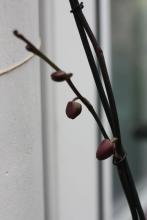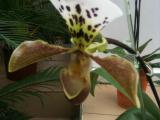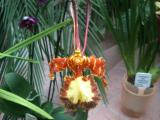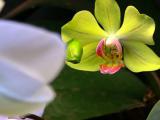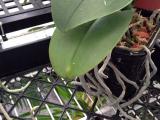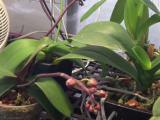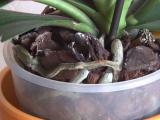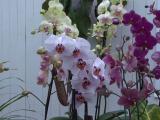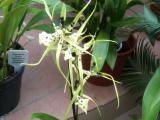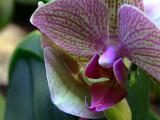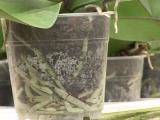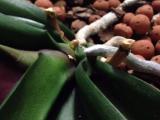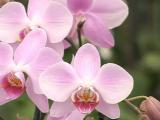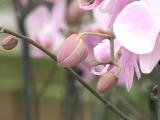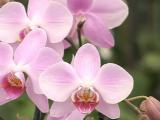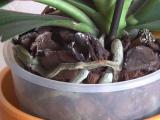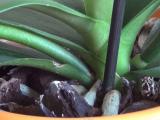Phalaenopsis orchid is the species which is quite easy to take care of even for beginners. It can forgive a lot of sins but when it falls sick, it will let...
-
Images of Phalaenopsis Orchid and pictures
Click here to see all articles about Phalaenopsis Orchid
Phalaenopsis Orchid Plant - Your Guide to the World of Orchids
Maintaining a hybrid Phalaenopsis orchid is traditionally considered a task for beginners because of the plant’s ruggedness, long flowering and being easy to take care of. Another reason is that the orchid is sold even in the smallest flower shops and large supermarkets.
Over time more and more people realize that giving a plant as a gift instead of a dead bouquet is a lot more pleasant. The flower shops are full of white, yellow, red and lilac armfuls of Dutch hybrid Phalaenopsis. The maintenance of these orchids is the same regardless of size and whether you grow it indoor or outdoors.

When buying a Phalaenopsis orchid from a regular store it is guaranteed that it is a hybrid adapted to domestic conditions. The color may wary from white to a very dark purple shade with different kinds of spots, dots and streaks. The flower size can vary from 2 to 13 cm in diameter. The number of flowers on a single spike depends on its ramifications and the general state of the plant and usually ranges from 3 to 40 units with or without odor.
Phalaenopsis Orchid Varieties. Are Blue Orchids Real?
Phalaenopsis flowers come in a variety of shapes, sizes and colors; with all the available technology there will probably be even more surprising color than just old plain blue that you can in see in different gardening picture and phalaenopsis orchid images.
Phalaenopsis is often called “the butterfly orchid” because of its charming flowers of various shapes, sizes, patterns and colors that remind us of tropical butterflies. A graceful flower lip of an often contrasting color stands out among the spectacularly patterned or smoothly colored petals of the flower that reaches 8 cm in diameter.
There are two types of phalaenopsis orchid of Phalaenopsis: standard and miniature. During the flowering, the standard types reach the height of 1 meter with a dozen or more flowers on long peduncle; the miniature types do not exceed the height of 30 cm and have fewer flowers on a short peduncle. Different species and sorts of Phalaenopsis orchids bloom at different times, each orchid can bloom up to 3 times a year. The leaves grow in pairs up on the rhizome. Abscission of the lower older leaves is a normal process, that is why the plant does not expand and grow bulkier. The plant has no pseudobulbs but a huge number of roots, which it uses in order to cling to the bark of trees and rocks.
Phalaenopsis is an unpretentious evergreen, ever-growing orchid; its species bloom almost all the time of the year and are ideal for beginners. With a proper care they bloom abundantly for a long time and can live in your house up to 7 years.
If you see a plant that resembles a butterfly in a transparent pot with gray-green roots pointed in different directions, without a stem, with a dense rosette of leaves and flowers you can be 100% sure that it is Phalaenopsis.
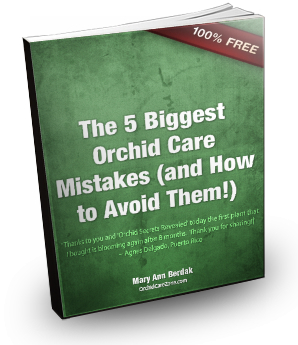
5 Biggest Orchid Mistakes (and How to Avoid Them!) DOWNLOAD NOW
First of all, this orchid is no ordinary plant that has its roots deep inside the land but an epiphyte that grows on trees using them as support. The roots absorb rainwater, moisture from the air and the nutrients are received from the decayed remains of the plants that are accumulated in the cortex. Furthermore, the roots are involved in photosynthesis and have a light green color. In addition to the roots that serve for attachment the Phalaenopsis orchid has aerial roots that are uses to extract moisture from the air. That is why you should not be surprised if your plant attempts to climb into the neighboring pots or the roots are just hanging in the air.
From all the mentioned facts we can make several conclusions:
· The pot and the substrate common to the other indoor plants in case of a hybrid orchid is required mainly for support.
· The roots need light and air.
· There is no way that the roots should be in the water.

Phalaenopsis Orchid Care. Care Instructions for Everybody
A healthy plant has hard leaves, dense to the touch gray-green roots that can get out of the substrate. Most orchids are sold in transparent pots, so be sure to check out how the roots look like inside the pot: in places where there is access to light, for example the walls, they should have a green-gray color.
Try gently shaking the plant’s base rosette of leaves. If you have an impression that the plant is hanging out of the pot it is likely that it has a problem with roots, so it is better to choose another one. Small mechanical leaf damage like scratches or cracks might be admissible. If the orchid has a limp or yellowing leaves, stains of different colors or dark roots, you can buy it only when you have enough experience in intensive caring for phalaenopsis orchid. The Phalaenopsis orchid’s lower leaves eventually turn yellow and dry out as they grow old. This is a natural process and should not be considered a defect of a disease.
Phalaenopsis Orchid Growing Conditions
Phalaenopsis orchid requires a warm place with diffused light without any direct sunlight. So how to grow a beautiful orchid? It grows well in the back of a room with sufficient artificial light. With the lack of light and when the temperature drops below 16 degrees the buds can fall off.
Growing Phalaenopsis Orchids From Seeds
Asymbiotic propagation is the simplest form of orchid seed germination, which is used by commercial growers.
Lighting
Providing the necessary lighting for Phalaenopsis is quite simple. To find the best place for your orchid you need to remember that epiphytes grow on trees and the sun’s rays fall on them only through the leaves of other trees. They will gladly grow anywhere on moderately lighted west, south-west or south-east windows. If direct sunlight affects the plant, it might burn the leaves. The plant can be placed both on a window-sill and next to it, although the distance should not be more than one meter from the window. If the window faces the south, the shade from sunlight is mandatory from late spring to autumn, in September depending on the weather the shading can be removed. In any case, the duration of daylight should vary from 12 to 16 hours. Phalaenopsis gradually tilts to the light, therefore, it is recommended to periodically rotate it by 180 degrees so that it does not fall out of the pot and lose its decorativeness. You should not disturb and move the plant in case if the buds just began to form on the spike. A week later since the last bud has started to blossom, the plant can be relocated or rotated.
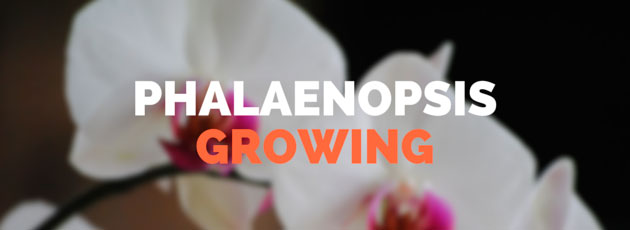
Temperature
The orchid blossoms longer in light shade and a temperature of 18 - 25 ° C. The normal temperature range varies from 18 to 25 ° C. A short-term increase in temperature during the warmer time of the year is possible up to 35 ° C. If the orchid finds itself at high temperatures for a long time, its flowers may fall off and the leaves lose turgor. During the cold season the lowest temperature is 12 ° C. The normal temperature is about 15 - 25 ° C.
Phalaenopsis does not have an expressed dormant period and requires only a small decrease in temperature during winter. In summer the daily temperature varies approximately from 25 C to 30 C, in winter from 20 to 25 C. The difference between the daily and nightly temperature is very important because thanks to it the plant’s flower buds are formed.
If you put your plants on a window-sill, you should be aware that the temperature there is much lower during the winter, so it is recommended to put a thermometer on the window-sill in order to be able to react in time in case of a prolonged downturn of temperature. In case it is not as prolonged downturn and the day or night temperature drops until 10-15 C you should not be alarmed, this orchid can support it. However, if such downturn is stable within a few day, it can lead to serious illness and death of the plant.

5 Biggest Orchid Mistakes (and How to Avoid Them!) DOWNLOAD NOW
During a long-term decrease of temperature the Phalaenopsis roots cease to absorb the water, leaves lose their elasticity and wrinkles appear. In case of such freezing, the plant lives and feeds exclusively due to moisture and nutrients accumulated in the leaves. Beginners might think that the plant lacks water and, therefore, it is better to increase the intensity of watering, but this will only worsen the situation as it will lead to rotting of the roots and various diseases. The basic ways of preventing the “freezing” would be sealing all cracks in the frames and placing the plant as high as possible on the window-sill so that the pot and leaves do not touch the cold glass.
It should be also noted that at any time of the year Phalaenopsis enjoys fresh air but does not tolerate drafts.
Humidity
The optimum moisture for maintaining Phalaenopsis varies from 60-80%. Low humidity during the winter remains a weak point in the maintenance not only of the orchids but also other plants. The main solutions to this problems are:
· Try to isolate hot and dry air so it does not go directly to the plant.
· Spray the plant at least one time a day in the morning. At night the plant should be dry at low temperatures, so you need to know when to stop.
· You can try filling the tray with expanded clay or small pebble, then pouring a little water and placing the pot with Phalaenopsis on top of the tray. The evaporating water from the tray with raise the humidity level around the plant.
Watering
The watering should be very mild all year round, especially in winter. The substrate should not dry out much butt before the next watering you need to let it dry slightly, the orchid’s roots besides the water need air. Excessive watering may cause fungal infections. The water should not enter the growth point the center of the rhizome to prevent it from rotting. Phalaenopsis can be watered by using a “bathing method”, when a half of the pot is omitted into a bucked with soft water for a short time to let the substrate saturate.
Air humidity
Phalaenopsis orchid requires constant maintenance of high humidity in all possible ways. Spraying the leaves and the air around the orchid should be done in the “mist mode” so that the water drops do not get to the core of the rosette of leaves or it will lead to decay.
Fertilizing
Phalaenopsis orchid absorbs nutrients through the roots therefore the fertilizers should all be water-soluble and less concentrated. In any case you cannot fertilize a dry substrate, it will burn the roots, first you need to water the plant. After this you need to water the plant with the dissolved fertilizer and make sure for the water to drain. If you plant has problems with roots it cannot be fertilized. In this case you can spray the plant with dissolved fertilizer.
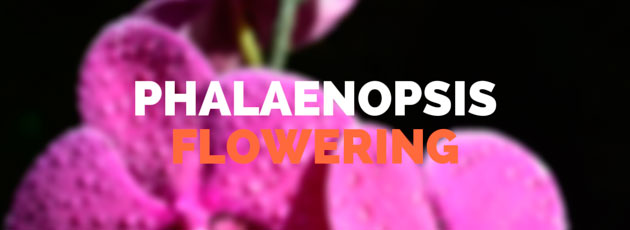
Maintenance after Flowering
In order to initiate the blooming of Phalaenopsis orchid you need to put it in a cooler place and reduce watering, only sprinkling the substrate and occasionally watering the plant. Blooming at optimal temperatures can last up to 6 month. To prolong the blooming you can try spraying the stems with warm water. After flowering the cutting of the orchid’s flower spike is not necessary. You can cut the stems only when they are completely dry. Modern orchid hybrid’s spikes tend to branch.
Repotting. How to Plant Phalaenopsis Orchid?
The repotting of Phalaenopsis orchid into loose crumbly substrate and a pot a little bigger than before is carried out once a year. So when to transplant Phalaenopsis orchid? When transplanting phalaenopsis orchid you want to minimize damage to the fragile roots that are exposed to the edges of the pot. It is recommended to fertilize the orchids two times in the summer with low concentrated fertilizer; during the rest of the year it is better to use even lower concentrations.
Phalaenopsis has fragile roots, therefore, it is recommended to repot it no more frequently than once every two-three years. During this time the substrate must maintain its properties and not decompose.
Furthermore, it must be sufficiently hygroscopic and air permeable. The most popular components of the mixture for the substrate are pieces of bark, sphagnum moss, charcoal, clay, bits of cork or foam. The last ones might sound a bit strange but we should remember that Phalaenopsis orchid uses the substrate mainly for support. The condition of the substrate should be regularly checked and replaced immediately in case of its destruction.
How to Prune Phalaenopsis Orchid Plants?
When all flowers on a spike have faded and fallen off, you may remove the old spike with no harm to the plant.
Pests and Diseases. How to Care for Infected Plants?
Most of diseases are caused by violation of the temperature or watering mode. Extensive watering at high or low temperature leads to the development of fungal diseases and can easily lead to death of the whole plant.
Excessive moisture is a major cause of the illness. Do not spray the plant at night. The orchids are attacked by the same pests as the other houseplants, therefore, the same methods for dealing with them apply. Curling of the leaves might also be a virus.
All publications about Phalaenopsis Orchid are below
Some people are lucky to live in the areas where the weather is mild and the growing conditions are appropriate to cultivate phalaenopsis orchid outside all...
Keeping a pet at home presupposes great responsibility. No wonder many pet owners are preoccupied with the safety of their animals when growing a moth orchid...
Occasionaly transplanting phalaenopsis orchid is necessary. If you have doubts about when to transplant the species, here is the hint. As a rule the plant...
You have a wonderful orchid and everything is fine when suddenly the blossoms start wilting and falling off. Don’t become panic-stricken: fading blooms do not...
A lot of people grow phalaenopsis hybrid orchid having no idea that this exact species has been...
I’ve never really come across problems with my orchid until recently. A few weeks ago I was so careless that I burnt phalaenopsis orchid. I left it on the...
It’s an unfeigned pleasure to watch your orchid grow and bloom. Growing a mature happy plant right from the moment it was just a tiny shoot is incomparable...
You may notice one day that flowers of your orchid have become fragile and started falling off, curling leaves have turned yellow and looked unhealthy. And...
A few days ago I was in a mood to do some shopping. I didn’t intend to purchase something particular, just wanted to find something for my apartment that will...
If you are looking for something that will enliven your interiorscape, phalaenopsis orchid is a prime candidate for that. You can have a look at the pictures...
There are 2 types of potting medium for orchids generally used by people: sphagnum moss and bark. Every way of growing the plant, either potting phalaenopsis...
Phalaenopsis orchid plants are exquisite succulents popular with growers all over the world. The origin of this species is eastern Asia. The plant is native...
One of the most pleasant things in keeping orchids is their blooming period. Although these plants are considered to be hardy, they are prone to some...
Phalaenopsis orchid violet has a scientific name phalaenopsis violacea. This species bears small star-shaped, fragrant, rich purple flowers. Sometimes the...
There is no bigger joy than to see your orchid thrive. Sometimes it is difficult to create the atmosphere in which the plant will be able to prosper. Growing...
It this article we will focus on phalaenopsis orchid culture for people who are new to plant growing in particular. The history of this wonderful species...
Viruses are organisms the naked eye can’t see. You will be able to see them only through microscopes when their images will be amplified several thousand...
Gardeners fall into two types: nurturers and neglecters. For the first ones growing orchids is very simple. For the second category keeping phalaenopsis...
In nature orchids are pollinated by insects, in cultivation people do it. If you have successful experience in growing healthy plants that produce flowers...
If you have noticed black spots on phalaenopsis orchid, that usually signifies that the plant is...
Phalaenopsis orchids fungus may vary from solely cosmetic to potentially fatal. Fungus can strike even hardy species. Luckily, prompt and correct treating...
Finding the right pot size for phaleonopsis orchid will contribute to the growth of the plant. The ideal pot is the one where the species is potted tightly...
If you have purchased or decided on planting phalaenopsis orchid and you still don’t know how to take...
“How long does phalaenopsis orchid live?”- that is one of the most frequent questions shop assistants in the florist’s are being asked. There is no certain...
Orchid phalaenopsis is one of the most popular plant to grow at home and its maintenance is quite easy. Still a lot of people are confused when the...
The most frequent question asked by people who keep Moth orchids at their homes is “How to repot a phalaenopsis orchid and when is it better to do it?”. The...
A friend of mine has phalaeonopsis orchid at her place. It’s called “Blue Mystique” and it’s absolutely fascinating with its electric-blue color. I didn’t...
Mini phalaenopsis orchid is a modern hybrid which produces flowers in cooler temperatures. Taking care of this species is similar to looking after standard...
Once phalaenopsis orchid stops producing flowers, it enters the period of dormancy. This resting period lasts from 6 to 9 months. Dormancy makes it possible...
Phalaenopsis orchid is a spectacular plant whose flowers resemble a flurry of moths surrounding the stems. It enjoys direct sunlight, perfect drainage and...
“If you have decided to purchase an orchid and give it as a present to a friend of yours , you should be concerned with the fact that it might turn into a...
If you are a beginner at plant growing, dealing with phalaenopsis orchid for the first time can be tough experience....
Taking care of phalaenopsis orchid plant at home is not as difficult as many people think. If you do...







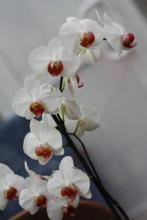 ,
, 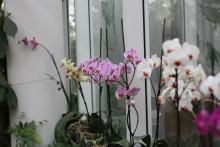 ,
, 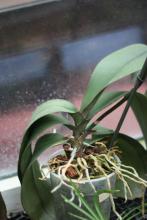 ,
, 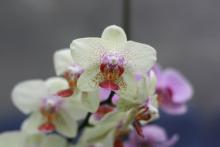 ,
, 